American Graffiti (1973)
Starring Ron Howard, Richard Dreyfuss, Cindy Williams, Paul LeMat, Charles Martin Smith, Candy Clark, Mackenzie Phillips, Wolfman Jack, Harrison Ford, Bo Hopkins, Suzanne Somers, Joe Spano and Kathleen Quinlan. Directed by George Lucas. From Universal Pictures.

American Graffiti is one of my Top 25 favourite movies; it is among my Top Ten of the films I have discovered as an adult. I have hesitated to write down my thoughts on this movie as I have always known that the task would be daunting. Not only is there so much story to the making of this film, there is much to say about the ensemble cast, about the writer/director, George Lucas, and I knew I would also have much to relate about what the movie has come to mean to me. As my discussion of the cast grew to epic proportions, I had something of an epiphany. I decided I would have to do something I hadn’t attempted before and write a review in multiple parts. The point of discussing American Graffiti is that there is so much to discuss; to condense it would have been foolish and pointless. And so, here is Part One of my look at this landmark film. Let’s take a look at the plot and the cast.
The PLOT
It’s a hot night in late summer in Modesto, California in 1962. Best friends, Steve (Howard), Terry (Smith) and Curt (Dreyfuss) meet at their hang-out, Mel’s Drive-In. The talk is about Steve and Curt leaving town for college the next morning but Curt seems unsure that he really wants to go. Regardless, the three buds decide they will have one more big night before the gang is split up. Mel’s starts to fill up with kids and their cars and the ever-present Wolfman Jack is heard on every car radio for miles.
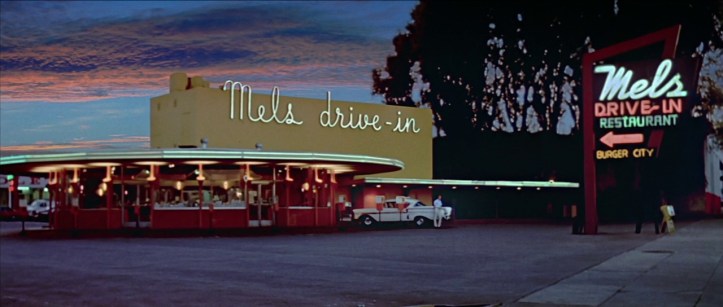
Steve’s girlfriend and Curt’s sister, Laurie (Williams), pulls up in the family’s Edsel. As the sun sets, in roars John Milner (LeMat) in his souped up deuce coupe. John is a legend in these parts and is known to have the fastest car in the valley. He is the oldest member of this group of friends. He never went to college and is content to bomb around in his car and be the greatest. As he pulls up, Steve notes to the reluctant Curt that if he doesn’t go off to school he will end up directionless, like John. Steve tells Terry that he is leaving his Impala in his care while he is off at school. Terry is overcome with emotion. The gang announces they are going to the freshman hop at their old high school to reminisce. John thinks that’s foolish and drives off in a huff to look for girls.
Eventually, the friends are separated and each get into their own adventure. Steve thinks he wants to see other girls while he’s away at school but when he tells Laurie this they have a big fight. She kicks him out of her car and leaves him stranded out at the make-out spot, the canal. Curt cruises with a couple of girl friends but when he acts like a jerk he also gets kicked out of the car and stranded. He sees a blonde dream girl (Somers) in a white 1956 Thunderbird and chases her but gets picked up by the local gang, the Pharaohs, who drive around in their Mercury with Curt, looking for mischief. They debate about where the Wolfman broadcasts his radio show from, whether or not the dream girl blond is a prostitute, rob the local arcade and initiate Curt into the gang by having him get even with local cop, Officer Holstein.
Cruising for chicks, John proves himself to be none too choosy and invites anyone in a neighbouring car to come riding with him. When Carol (Phillips) hops in his deuce coupe John is angry to find she is much too young for him. While they drive around looking for Carol’s sister, John runs into a ’55 Chevy that has been looking for him. Milner trades barbs with the driver, Bob Falfa (Ford), and the two drag. Falfa pulls away from John but John laments Bob’s careless driving while he himself has never had an accident. John and Carol fight but eventually come to like each other.
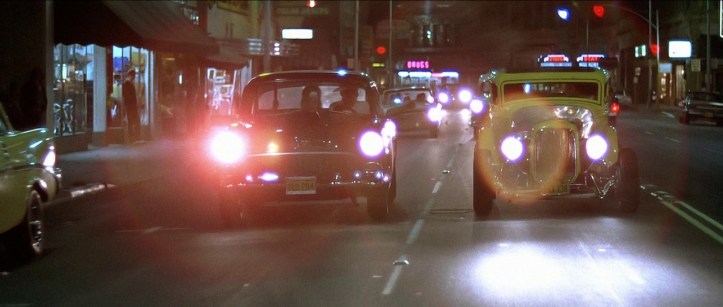
In Steve’s Impala, Terry feels like a new man; no longer “Terry the Toad”, he has become “Terry the Tiger”. He spies pretty Debbie (Clark) walking alone and picks her up (“Buenas noches?”). She digs his car and asks him to peel out. Terry plays the part of the Tiger, telling Debbie all manner of lies about the other vehicles he owns and his hunting exploits. The two score some liquor and head out to the canal – where Steve’s car is stolen out from under Terry’s nose.
Steve stumbles on Terry and Debbie (“Where’s my rod?”), Curt actually meets the mysterious Wolfman but not the elusive blonde, Laurie ends up cruising with Falfa and the gang all meet up out at Paradise Road where Milner will pit his car up against Falfa’s. As the sun rises…
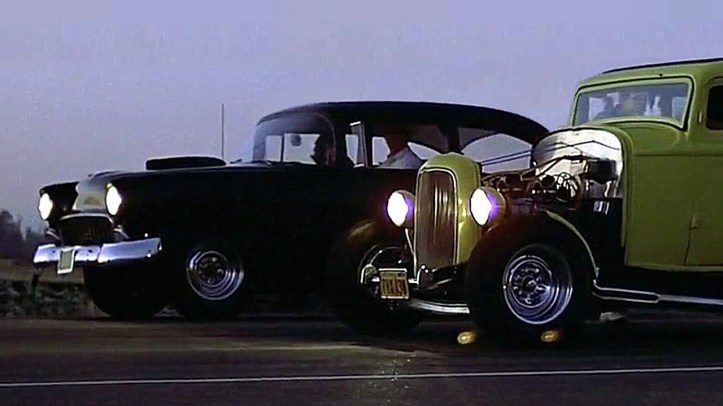
The CAST
 Ron Howard (billed here as “Ronny”) could hardly be called a “newcomer” even as early as 1973. His iconic run as Opie Taylor on The Andy Griffith Show had brought him into people’s living rooms for eight years starting in 1960. He had appeared notably on the big screen as Glenn Ford’s son in 1963’s The Courtship of Eddie’s Father but by the time he was cast in our film, he had transitioned from child to young adult and quality roles had eluded him. His role as Steve Bolander in American Graffiti cast a new light on him and he would go on to appear in the sequel – More American Graffiti – and John Wayne’s last film, The Shootist. He created a second iconic television character throughout the 1970’s with his portrayal of Richie Cunningham on Happy Days. Despite his acting triumphs, though, his career as an actor is moot as Ron Howard has become one of the most prolific and acclaimed directors and producers of his era. His resume is impressive: Night Shift, Splash, Cocoon, Gung Ho, Apollo 13, A Beautiful Mind, Solo: A Star Wars Story. He has been nominated for four Oscars, winning Best Director and Best Picture for A Beautiful Mind. He directed his American Graffiti co-star, Kathleen Quinlan, to an Oscar nomination in Apollo 13 and by directing his Han Solo movie, he aligned himself with a character made famous by Harrison Ford, who also appears in our movie.
Ron Howard (billed here as “Ronny”) could hardly be called a “newcomer” even as early as 1973. His iconic run as Opie Taylor on The Andy Griffith Show had brought him into people’s living rooms for eight years starting in 1960. He had appeared notably on the big screen as Glenn Ford’s son in 1963’s The Courtship of Eddie’s Father but by the time he was cast in our film, he had transitioned from child to young adult and quality roles had eluded him. His role as Steve Bolander in American Graffiti cast a new light on him and he would go on to appear in the sequel – More American Graffiti – and John Wayne’s last film, The Shootist. He created a second iconic television character throughout the 1970’s with his portrayal of Richie Cunningham on Happy Days. Despite his acting triumphs, though, his career as an actor is moot as Ron Howard has become one of the most prolific and acclaimed directors and producers of his era. His resume is impressive: Night Shift, Splash, Cocoon, Gung Ho, Apollo 13, A Beautiful Mind, Solo: A Star Wars Story. He has been nominated for four Oscars, winning Best Director and Best Picture for A Beautiful Mind. He directed his American Graffiti co-star, Kathleen Quinlan, to an Oscar nomination in Apollo 13 and by directing his Han Solo movie, he aligned himself with a character made famous by Harrison Ford, who also appears in our movie.
 Richard Dreyfuss is by no means my favourite actor. He does, however, appear in no less than 3 of my “Top 23” favourite movies and one other film that I hold dear. Dreyfuss started his film career with two uncredited appearances, one in Valley of the Dolls and the other in The Graduate. For his role as Curt in his fifth film, American Graffiti, he received a Golden Globe nomination. Later, in 1974, he appeared in the title role in The Apprenticeship of Duddy Kravitz, a Canadian film based on one of my two favourite novels that was nominated for a writing Oscar but lost out to The Godfather Part II. Dreyfuss then appeared in three consecutive landmark films starting in 1975; Jaws, Close Encounters of the Third Kind and The Goodbye Girl. The last of these may not be as “landmark” as the others but it did land Dreyfuss the Oscar for Best Actor that year. He soon hit a valley, though, as his second role after nabbing the Oscar saw him nominated for the Golden Raspberry for Worst Actor. He righted the ship in the 1980’s, though, appearing in Stand By Me, Tin Men, Stakeout, Nuts – for which he was nominated for a Golden Globe – and What About Bob? After another Best Actor Oscar nom for 1995’s Mr. Holland’s Opus, Dreyfuss has continued to make films, if unremarkable ones.
Richard Dreyfuss is by no means my favourite actor. He does, however, appear in no less than 3 of my “Top 23” favourite movies and one other film that I hold dear. Dreyfuss started his film career with two uncredited appearances, one in Valley of the Dolls and the other in The Graduate. For his role as Curt in his fifth film, American Graffiti, he received a Golden Globe nomination. Later, in 1974, he appeared in the title role in The Apprenticeship of Duddy Kravitz, a Canadian film based on one of my two favourite novels that was nominated for a writing Oscar but lost out to The Godfather Part II. Dreyfuss then appeared in three consecutive landmark films starting in 1975; Jaws, Close Encounters of the Third Kind and The Goodbye Girl. The last of these may not be as “landmark” as the others but it did land Dreyfuss the Oscar for Best Actor that year. He soon hit a valley, though, as his second role after nabbing the Oscar saw him nominated for the Golden Raspberry for Worst Actor. He righted the ship in the 1980’s, though, appearing in Stand By Me, Tin Men, Stakeout, Nuts – for which he was nominated for a Golden Globe – and What About Bob? After another Best Actor Oscar nom for 1995’s Mr. Holland’s Opus, Dreyfuss has continued to make films, if unremarkable ones.
Cindy Williams had no credits to speak of when she was cast as Laurie Henderson. After American Graffiti and it’s sequel, her film career lacks note, to say the least. She will be forever remembered, though, as Shirley Feeney on TV’s Laverne and Shirley, which had spun-off from Ron Howard’s Happy Days. Likewise, Mackenzie Phillips got her start in our film and went on to star in a successful ’70’s sitcom. Phillips is the daughter of John Phillips of the Mamas and the Papas and was 12 years old when she appeared in American Graffiti. Afterwards, she co-starred on TV’s One Day at a Time during a point in her life marred by substance abuse. Later she performed with a new version of her father’s group and also made noise with an autobiography that claimed she had engaged in a sexual relationship with her father. The third female in our movie to later find success on television is Suzanne Somers who had no lines as the “blonde in the T-Bird”. Somers played gorgeous but ditzy Chrissy on the almost unbearable Three’s Company.

Candy Clark’s story I find interesting. Clark was the only actor to receive an Oscar nomination for her role in American Graffiti and the sequel to the film was largely built around her but aside from her appearance in The Man Who Fell to Earth (which coincidentally contained music by John Phillips) her career has not amounted to a thing. Her Oscar nom notwithstanding, she is the only member of this cast to not turn up in another notable role.
Audiences watching American Graffiti in the theaters in 1973 probably predicted that Paul LeMat would go on to have a stellar acting career. Not so. For his portrayal of the prototypical hot-rodder, John Milner, LeMat received a Golden Globe award for New Star of the Year. After reprising his role as Milner for More American Graffiti, LeMat starred with Jason Robards in Melvin and Howard earning a Golden Globe nomination. He would add another Golden Globe to his name for his portrayal of Farrah Fawcett’s abusive husband in the TV movie The Burning Bed. These accomplishments aside, though, LeMat has fallen short of the heady predictions made about him after his appearance in our film. One thing for certain, though; he will forever be revered by men of a certain age for playing the immortal John Milner, owner of the yellow 1932 Ford Deuce Coupe.
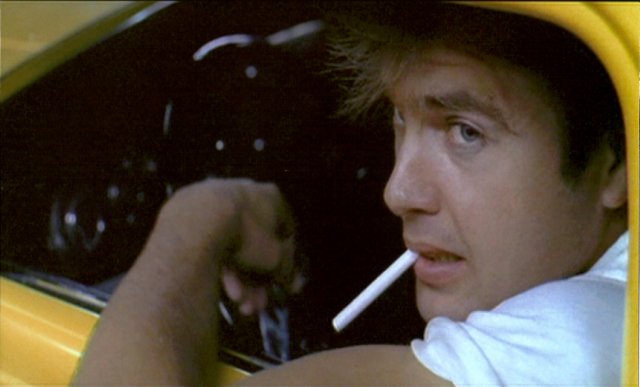
Charles Martin Smith was one of the unknowns cast in our film and he would go on to portray The Toad in the sequel. He later appeared in The Buddy Holly Story and The Untouchables but really made an impact with his work in Never Cry Wolf. That film was made in Canada and Smith fell in love with the country and eventually settled there; he still lives in Vancouver. He has since turned to directing and has helmed successful children’s films such as Air Bud and two Dolphin Tale movies. Smith and Bo Hopkins had no scenes together in American Graffiti but were paired in Vietnam in the sequel. Hopkins had appeared notably in The Wild Bunch in 1969 and could also be seen in The Getaway before appearing as Pharaoh Joe. Later, he accumulated countless credits but none to write home about. Interestingly, Bo would go on to portray a sheriff no less than ten times.

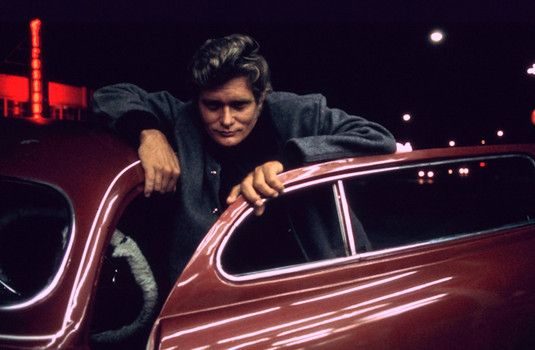
By 1970, Harrison Ford had made 6 films although his roles were minuscule. He had become disillusioned with the Hollywood machine and had been working as a carpenter when he was chosen to play Bob Falfa. During filming, he forged a relationship with both George Lucas and Graffiti‘s producer, Francis Ford Coppola, that would have a lasting effect on Ford’s career. He won the role of Han Solo in Lucas’ next project, Star Wars, and Ford became an international star. This did not stop him, though, from taking a small role in Coppola’s Apocalypse Now and reprising his role as Falfa – now a motorcycle cop! – in the Graffiti sequel. He would of course go on to become one of the biggest leading men of the modern era appearing in other films in the Star Wars franchise and another blockbuster series, the Indiana Jones films and both Blade Runner movies.
Wolfman Jack was a legendary radio personality and his depiction in American Graffiti is based largely on fact. As in the film, the Wolfman was a mysterious and racially ambiguous figure adored by teenage radio listeners across the country. He did, indeed, work for XERB and other “border blaster” stations located in Mexico that were so powerful that “birds dropped dead when they flew too close to the tower. A car driving from New York to L.A. would never lose the station”. At night their signals could be picked up in the Soviet Union. In the film, the conjecture regarding the Wolfman and the mystery surrounding his whereabouts were drawn from real life. The whole idea of the disc jockey being a constant companion and hero to these kids is a charming aspect of Lucas’ story.
Next up in Part 2, we’ll take a look at the team George Lucas assembled to make this personal story.
Great stuff here, Gary, I’m looking forward to the next instalment. Perhaps letting slip how boring I am, this film is a New Years Eve tradition at our house, along with The Last Waltz. For me, one of the great aspects of this story is the interaction between MacKenzie Phillips and Paul leMat as they end up stuck with each other for the night; One great moment is when MacKenzie (apparently accidentally) gets hit full in the face with the water bomb. Her spontaneous reaction just about makes the entire film.
Thanks, George. I love that you watch this on New Year’s Eve, that’s great! (It’s the original “Ocean’s 11” at our house). I also love John and Carol. There is great comedy that comes from their story and yes apparently it was accidental, her getting the balloon in the face! It’s a great part of the wonderful interaction between the two of them. I like to imagine as well that younger Carol “dined out” on her friendship with John for a long time. It would have been a feather in her cap among her friends, I’m sure, having him as a friend.
[…] To lend a “name” to his sophomore project in an effort to secure funding from a studio, Coppola, who’s stock in Hollywood was on the rise as word of his work on the as-yet-unreleased The Godfather had the industry abuzz, once again came on board as producer. Coppola and Lucas worked together on many aspects of the film. Both filmmakers were of the “new breed” and were ushering in a new era of maverick movie making. On the subject of casting, both men were intent on using a group of newcomers that would work well in an ensemble. After much effort assembling actors and having them work in various groups ad-libbing and fleshing out the characters, the cast was chosen (see Part 1). […]
[…] old favourites around Labour Day, William Inge’s play Picnic and a novelization of the two American Graffiti screenplays called The Complete American Graffiti: The […]